人教版七年级英语语法
人教版初中英语七年级上册语法知识点
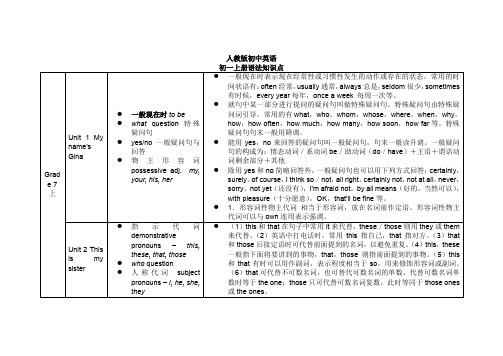
have表示“有”时,其否定形式有两种:在其后直接加not,但常用于非正式用语中;利用助动词do加not。
②如果句子的谓语是实义动词,在谓语动词前加don't,doesn't,didn't。
③no,never,seldom,hardly,nobody,little,few,nothing等否定词也可以构成否定形式。
1.表示经常性或习惯性发生的动作2.表示现在存在的状态或情况3.表示正在发生的动作或存在的状态4.表示客观事实、真理和自然现象5.用于表示较固定的、按计划、规定将要发生的动作,但只限于begin,come,go,leave,arrive,stop,return,close,open,take,start,take,place等少数动作,6.用于if,unless,once,even if(即使)等引导的条件状语从句,when,before,until,as soon as,the moment(一……就)等引导的时间状语从句,no matter+wh-/-how-或wh-ever/however等引导的让步状语从句中,代替一般将来时
人教版初中英语
初一上册语法知识点
Grade 7
上
Unit 1 My name’s Gina
人教版 七年级英语各单元语法梳理

人教版七年级英语各单元语法
梳理
1. Her clock is on the desk. 她的闹钟在书桌上。
2. My baseball is under the bed. 我的棒球在床下。
3. His keys are in his schoolbag. 他的钥匙在他的书包里。
【妙语诠释】
对上面这些例句中的划线部分提问,需要用特殊疑问词where,其句型结构为:Where be ...? 意为“……在哪里?”。
用来对位置提问,该句型中 be 的单复数要与其后主语的单复数保持一致。
例如:
-Where is her clock? 她的闹钟在哪里?
-Her clock is on the desk.
-Where is your baseball? 你的棒球在哪里?
-My baseball is under the bed.
-Where are his keys? 他的钥匙在哪里?
-His keys are in his schoolbag.。
人教版七年级英语上册重点短语总汇,语法总结

人教版七年级英语上册重点短语总汇,语法总结句型(1)-What+be+主语+doing? ….正在做什么?-主语+be+doing。
…正在做某事。
例:-what are you doing?-I’m doing my homework.(2)-Thanks for … 为。
而感谢例:Thanks for your letter.(3)-Here are/is…例:Here are some of my photos.Here is a photo of my family.(4)-That sounds good.(5)-This TV show is boring.三、日常交际用语(1)-Do you want to go to the movices? –Sure.(2)-When do you want to go? –Let’s go at seven.(3)-Where do people play basketball? –At school.(4)-What’s he waiting for?-He’s waiting for a bus.(5)-What’s he reading? He’s reading a newspaper.1)现在在进行时的形式是:助动词be(am,is,are)+动词-ing形式(也叫现在分词),表示现在(说话的瞬间)正在进行或发生的动作。
2)现在进行时的肯定句形式主语+be(am,is,are)+动词现在分词+其他I’m watching TV.3)现在进行时的否定句形式主语+be(am,is,are)+not+动词现在分词+其他They are not playing soccer.4)现在进行时的一般疑问句形式及回答:Is(am,are)+主语+动词现在分词+其他?Yes,主语+is/am/are. No,主语+isn’t/aren’t/am not.Are you reading? Yes,I am. No,I am not.5) 现在进行时的特殊疑问句形式:特殊疑问词+is/am/are+主语+现在分词+其他?例:What is your brother doing?6) 动词+ing形式(现在分词)的构成.1一般情况下在动词词结尾加-ing.如: eat--eating, do—doing,clean—cleaning,play—playing,2以不发音的元音字母e结尾的动词,先去掉e再加-ing.如:take--taking,write—writing,have-havingcome—coming.dance--dancing3词尾如果是以一个辅音字母结尾的重读闭音节词.应该先双写这个辅音字母,再加-ing.如:run—runing,sit—sitting ,swim—swimming.Shop—shopping.put—putting,sit—sittingUnit 6 It’s raning!一、词组Around The World 世界各地On vacation 度假Take photos 拍照On the beach 在海边a group of people 一群人play beach volleyball 打沙滩排球be surprised 惊讶的be surprised at sth./sb.对某人或某人感到惊讶be relaxed 放松have a good time 玩得很痛快in different kind of weather 在不同的天气里Thank sb for(doing)sth由于(做)某事而感谢某人How’s it going? 近况如何Some…others…一些…另一些…Look like..看起来像。
人教版初中英语七年级上册语法知识点总结
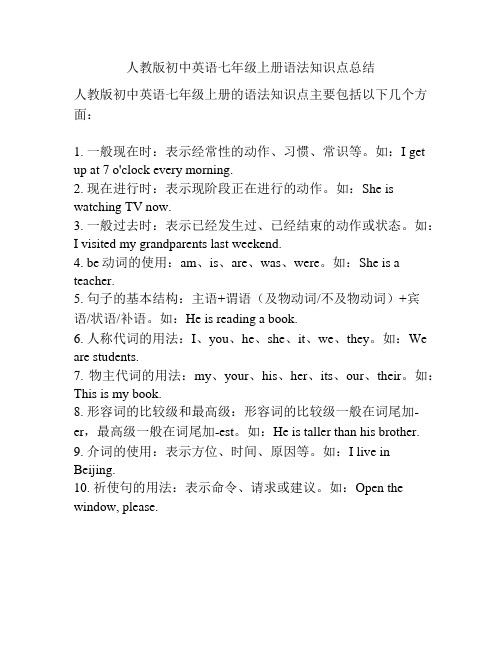
人教版初中英语七年级上册语法知识点总结
人教版初中英语七年级上册的语法知识点主要包括以下几个方面:
1. 一般现在时:表示经常性的动作、习惯、常识等。
如:I get up at 7 o'clock every morning.
2. 现在进行时:表示现阶段正在进行的动作。
如:She is watching TV now.
3. 一般过去时:表示已经发生过、已经结束的动作或状态。
如:
I visited my grandparents last weekend.
4. be动词的使用:am、is、are、was、were。
如:She is a teacher.
5. 句子的基本结构:主语+谓语(及物动词/不及物动词)+宾
语/状语/补语。
如:He is reading a book.
6. 人称代词的用法:I、you、he、she、it、we、they。
如:We are students.
7. 物主代词的用法:my、your、his、her、its、our、their。
如:This is my book.
8. 形容词的比较级和最高级:形容词的比较级一般在词尾加-er,最高级一般在词尾加-est。
如:He is taller than his brother. 9. 介词的使用:表示方位、时间、原因等。
如:I live in Beijing.
10. 祈使句的用法:表示命令、请求或建议。
如:Open the window, please.。
(完整版)新人教版七年级英语语法知识点汇总
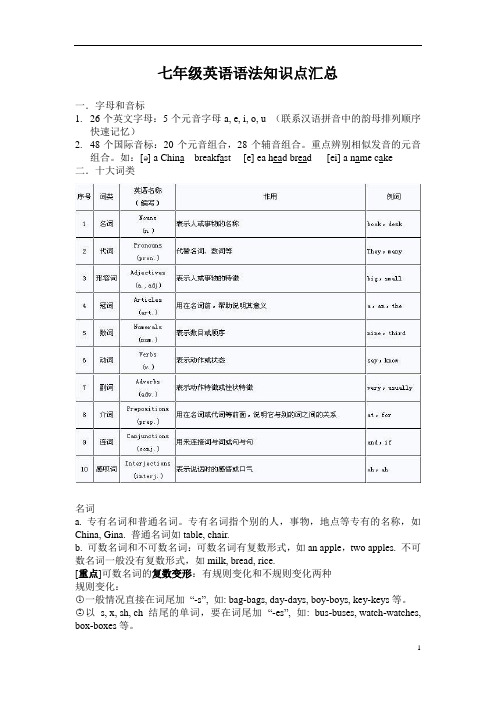
七年级英语语法知识点汇总一.字母和音标1.26个英文字母:5个元音字母a, e, i, o, u (联系汉语拼音中的韵母排列顺序快速记忆)2.48个国际音标:20个元音组合,28个辅音组合。
重点辨别相似发音的元音组合。
如:[ə] a China breakfast [e] ea head bread [ei] a name cake 二.十大词类名词a. 专有名词和普通名词。
专有名词指个别的人,事物,地点等专有的名称,如China, Gina. 普通名词如table, chair.b. 可数名词和不可数名词:可数名词有复数形式,如an apple,two apples. 不可数名词一般没有复数形式,如milk, bread, rice.[重点]可数名词的复数变形:有规则变化和不规则变化两种规则变化:○1一般情况直接在词尾加“-s”, 如: bag-bags, day-days, boy-boys, key-keys等。
○2以s, x, sh, ch结尾的单词,要在词尾加“-es”, 如: bus-buses, watch-watches, box-boxes等。
○3以辅音字母加y结尾的单词,要变y为i再加“-es”, 如:baby-babies, country-countries, family-families等。
○4部分以f (e)结尾的单词,要变f (e)为“ves”, 如:knife-knives, half-halves等。
顺口溜:小偷(thief)的妻子(wife),为了自己(self)保命(life),站到架子上(shelf),用树叶(leaf)做的小刀(knife),将狼(wolf)劈成了两半(half)○5以字母“o”结尾的单词,没有生命的加“-s”,有生命的加“-es”,如:zoo-zoos, photo-photos, tomato-tomatoes.口诀:黑人(Negro)英雄(hero)爱在火山(volcano)吃土豆(potato)西红柿(tomato)不规则变化:○1改变单数名词中的元音字母:man-men, woman-women, foot-feet, tooth-teeth等。
2024年初一(七年级)人教版英语语法知识点

2024年初一(七年级)人教版英语语法知识点1.词性(1)名词(Nouns):表示人、地点、事物或概念。
分为可数名词与不可数名词单数与复数(例如:cat-cats,water-不可数)(2)动词(Verbs):表示动作或状态。
分为实义动词与助动词动词的时态(一般现在时、一般过去时、将来时)(3)形容词(Adjectives):描述名词的性质或状态。
比较级与最高级(例如:big-bigger-biggest)(4)副词(Adverbs):描述动词、形容词或其他副词的方式、程度等。
(5)频率副词(如always,usually,sometimes,never)2.句子结构(1)简单句(Simple Sentences):只有一个主语和一个谓语的句子。
例如:I like ice cream.(2)并列句(Compound Sentences):由两个或多个简单句通过连词连接而成。
例如:I like ice cream,and she likes cake.(3)从句(Complex Sentences):包含一个主句和一个或多个从句。
例如:I will go to the park if it is sunny.3.时态(1)一般现在时(Simple Present Tense):表示习惯或经常发生的动作。
结构:主语+动词原形(第三人称单数加-s)例如:He plays football.(2)一般过去时(Simple Past Tense):表示过去发生的动作。
结构:主语+动词的过去式例如:They visited the museum.(3)将来时(Future Tense):表示将要发生的动作。
结构:主语+will+动词原形例如:She will go to school tomorrow.4.疑问句和否定句疑问句(Questions):一般疑问句:助动词+主语+动词原形例如:Do you like pizza?特殊疑问句:疑问词+助动词+主语+动词原形例如:What do you want to eat?否定句(Negative Sentences):结构:主语+助动词+not+动词原形例如:I do not like spinach.5.代词人称代词(Personal Pronouns):I,you,he,she,it,we,they物主代词(Possessive Pronouns):mine,yours,his,hers,its,ours, theirs反身代词(Reflexive Pronouns):myself,yourself,himself,herself, itself,ourselves,yourselves,themselves6.介词表示时间的介词:in,on,at例如:I was born in2005.表示地点的介词:in,on,under,between,behind 例如:The cat is under the table.7.连词并列连词:and,but,or从属连词:because,although,if,when8.常用短语表示喜欢或不喜欢的表达:I like/I don’t like...My favorite...is...表示能力的表达:I can/I can’t...9.常见错误注意主谓一致:如第三人称单数加-s。
人教版最全的七年级上册英语语法
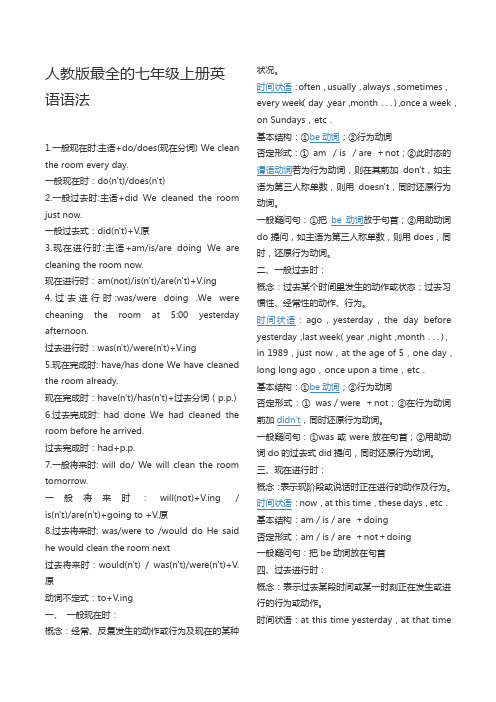
人教版最全的七年级上册英语语法1.一般现在时:主语+do/does(现在分词) We clean the room every day.一般现在时:do(n't)/does(n't)2.一般过去时:主语+did We cleaned the room just now.一般过去式:did(n't)+V.原3.现在进行时:主语+am/is/are doing We are cleaning the room now.现在进行时:am(not)/is(n't)/are(n't)+V.ing4.过去进行时:was/were doing .We were cheaning the room at 5:00 yesterday afternoon.过去进行时:was(n't)/were(n't)+V.ing5.现在完成时: have/has done We have cleaned the room already.现在完成时:have(n't)/has(n't)+过去分词(p.p.)6.过去完成时: had done We had cleaned the room before he arrived.过去完成时:had+p.p.7.一般将来时: will do/ We will clean the room tomorrow.一般将来时:will(not)+V.ing / is(n't)/are(n't)+going to +V.原8.过去将来时: was/were to /would do He said he would clean the room next过去将来时:would(n't) / was(n't)/were(n't)+V.原动词不定式:to+V.ing一、一般现在时:概念:经常、反复发生的动作或行为及现在的某种状况。
最新英语人教版七年级上册全册重点句型语法

最新英语人教版七年级上册全册重点句型语法1. 主语 + be动词 + 宾语- 例句:I am a student.- 翻译:我是一个学生。
2. 主语 + be动词 + 形容词- 例句:She is tall.- 翻译:她个子高。
3. 主语 + be动词 + 名词- 例句:They are teachers.- 翻译:他们是老师。
4. 主语 + be动词 + 地点- 例句:We are at school.- 翻译:我们在学校。
5. 主语 + be动词 + 时间- 例句:He is in the classroom at 8 o'clock. - 翻译:他在八点钟在教室里。
6. 主语 + be动词 + 副词- 例句:I am here.- 翻译:我在这里。
7. 主语 + have + 名词- 例句:We have a book.- 翻译:我们有一本书。
8. 主语 + have + 动词过去分词- 例句:He has finished his homework.- 翻译:他已经完成了他的作业。
9. 主语 + have + to + 动词原形- 例句:They have to study for the test.- 翻译:他们必须为考试研究。
10. 主语 + can + 动词原形- 例句:She can swim.- 翻译:她会游泳。
11. 主语 + can + 动词原形 + 物品- 例句:We can ride bicycles.- 翻译:我们会骑自行车。
12. 主语 + can't + 动词原形- 例句:He can't speak Chinese.- 翻译:他不会说中文。
13. 主语 + like + 名词/动词/动词-ing- 例句:They like basketball.- 翻译:他们喜欢篮球。
14. 主语 + don't/doesn't + like + 名词/动词/动词-ing - 例句:She doesn't like swimming.- 翻译:她不喜欢游泳。
人教版七年级上册英语语法
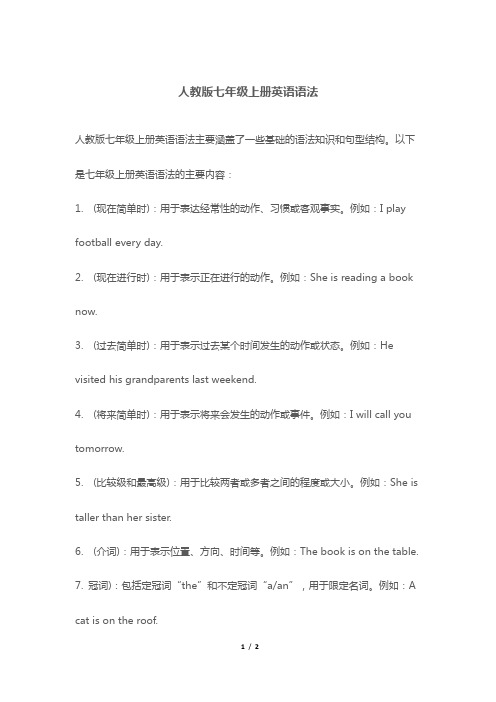
人教版七年级上册英语语法
人教版七年级上册英语语法主要涵盖了一些基础的语法知识和句型结构。
以下是七年级上册英语语法的主要内容:
1. (现在简单时):用于表达经常性的动作、习惯或客观事实。
例如:I play football every day.
2. (现在进行时):用于表示正在进行的动作。
例如:She is reading a book now.
3. (过去简单时):用于表示过去某个时间发生的动作或状态。
例如:He visited his grandparents last weekend.
4. (将来简单时):用于表示将来会发生的动作或事件。
例如:I will call you tomorrow.
5. (比较级和最高级):用于比较两者或多者之间的程度或大小。
例如:She is taller than her sister.
6. (介词):用于表示位置、方向、时间等。
例如:The book is on the table.
7. 冠词):包括定冠词“the”和不定冠词“a/an”,用于限定名词。
例如:A cat is on the roof.
8. (情态动词):如can, could, may, might, must, shall, should, will, would 等,用于表示情态、推测、建议等。
例如:You must finish your homework.
以上是七年级上册英语语法的一些主要内容,学生在学习过程中需要掌握这些基础知识,并能够正确运用到实际语境中。
(完整版)最全的人教版七年级英语语法总结
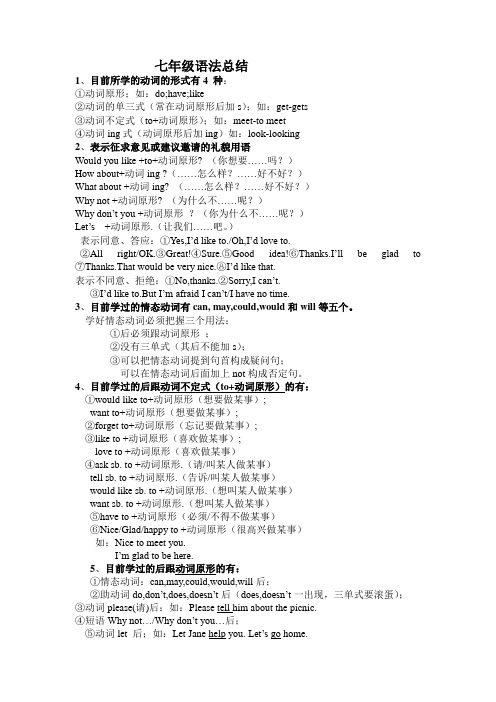
yuan---yuan(人民币元)
4) mouse—mice (老鼠) child—children(儿童)
5)合成词中一般变后面的词:apple tree---apple trees(苹果树)
但下列需前后都变:man teacher---men teachers(男教师)
woman doctor---women doctors(女医生)
7、有单复数变化的词
①名词
(1) 名词单数变复数的方法
1)大部分在词尾加 s.如:dog---dogs
2)以-s, -x, -ch, -sh 结尾的加 es. 如:
class---classes bus---buses glass---glasses
box---boxes watch---watches(手表)
How about +动词 ing? —How about g.o..in.g.fishing this Sunday?
It’s time for g.o..in.g.home=It’s time to go home.
Thank you for h.e..lp..in.g.me=Thank you for your help.. ③go +动词 ing——go fishing 去钓鱼; go shopping 去购物 ④do some shopping 购物 ⑤like/love +动词 ing (喜欢做某事)
⑥动词 help 后,也可带 to;如:Let’s help Maria (to) carry water. ⑦祈使句以动词原形开头,如:Have a seat , please.请坐下。 6、目前学过的后跟动词 ing 的有: ①Be 动词后的动词;如:Are you k..id.d..in.g.? I’m just .lo.o.k..in.g..
人教版七年级上册英语全册语法知识点梳理
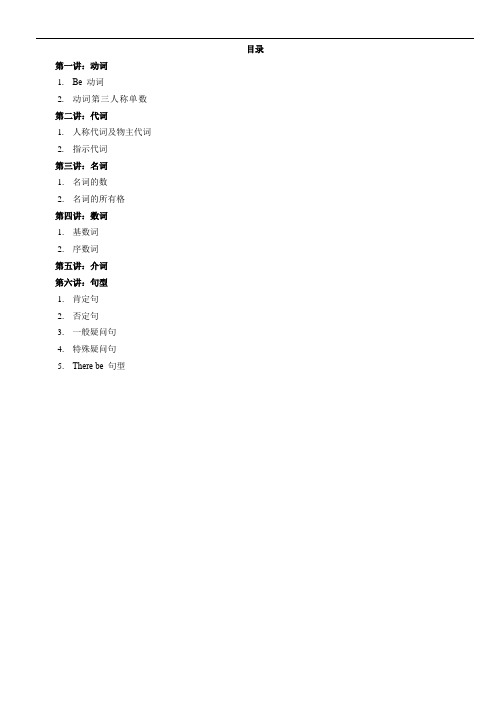
目录第一讲:动词1.Be 动词2.动词第三人称单数第二讲:代词1.人称代词及物主代词2.指示代词第三讲:名词1.名词的数2.名词的所有格第四讲:数词1.基数词2.序数词第五讲:介词第六讲:句型1.肯定句2.否定句3.一般疑问句4.特殊疑问句5.There be 句型第一讲:动词(一)Be 动词(am, is, are)的用法口诀:I 用am , you 用are ,is 连着他(he)她(she)它(it)。
单数统统用is,复数一律都用are. 变疑问,往前提,句末问号莫丢弃,变否定,更容易,be 后not莫忘记,疑问否定任你变,句首大写莫迟疑。
注意:be 动词通常会和其他词连写在一起,如:I’m , what’s ,name’s, they’re等For example:-What is your name?= -What’s your name?-My name is Cindy. = -My name’s Cindy.-Are you a student? = -Are you a student?-Yes, I am a student. = –Yes, I’m a student.-What are they? =-What are they?-They are apples. =They’re apples.What is this? =What’s this?ExercisesI ________ a student. You ________ Japanese.He _______ my brother. She_______ very nice.My name ________Harry. I _______ 10 years old.LiLei _________ very tall. Mary, this _________ Tom.What_____ this? Miss Zhou ________ my teacher.This book________ very interesting. Li Lei and I __________ good friends.These ________ apples. Those_________ bananas.They _________students. There _______ some bread on the plate.The cat________ black. ________ she from China?________ you good at English? The books ________ on the desk.The black pants ______ for Su Yang. This ______ not Wang Fang's pencil.Here ______ some sweaters for you. There ______ a girl in the room.This pair of boots ______ for Yang Ling. ______ David and Helen from England?There some milk for me. There ______ some apples on the tree._______ there any kites in the classroom? Gao Shan's shirt _______ over there.Some tea ______ in the glass. My sister's name ______Nancy._______ there any apple juice in the bottle? My telephone number ________ 8563-0770.(二)动词第三人称单数的构成规则:a.一般情况下在动词词尾加s 如:get----gets like----likes play—plays,want—wants,work—works,know—knows,help—helps,get—getsb. 以字母s、x、ch或o结尾的动词加-es;如:guess—guesses,fix—fixes,teach—teaches,brush—brushes,go—goes,do—does,watch—watches,catch—catchesc. 以辅音字母+y结尾的动词,先变y为i,再加-es。
Unit1语法点人教版七年级英语上册

Unit 1 You and Me 语法点*be 动词的用法*人称代词/物主代词一,be 动词的用法(1) be 动词是英语中很重要的一类动词,在一般现在时中的具体形式有三种,它们分别是: am, is, are如:她是凯特·格林。
She is Kate Green.你是我的好朋友。
You are my good friend.(2) 我是:I am = I’m(缩写)(第一人称)他/她/它是:she/he/it is= she’s/he’s/it’s(缩写)(第三人称单数)你是:you are= you’re(缩写)(第二人称)二,人称代词/物主代词(1),形容词性物主代词+名词(2),人称代词,分为主格和宾格;___主___格在谓语动词前做主语,是动作的___发出者;___宾___格在谓语动词后做宾语,是动作的承受者。
(3),形容词性物主代词表示“某人的”,其后一定要加名词。
且限定词有且只有1个。
如:这是她的一件夹克衫。
This is h er jacket.That is your a pen. ❌将正确的句子写在横线上:That is your pen___.(4) 缩写形式:我是: I am =I’m(缩写)(第一人称)我们是: we are =we’re (缩写)(第一人称复数)你(们)是: you are = you’re (缩写)(第二人称和复数人称)他是: h e i s =he’s(缩写)(第三人称单数)她是: sheis = she’s(缩写)(第三人称单数)它是: it is =it’s(缩写)(第三人称单数)他们是/她们是/它们是: they are = ___they’re (缩写)(第三人称复数)。
人教版七年级英语上册语法大全
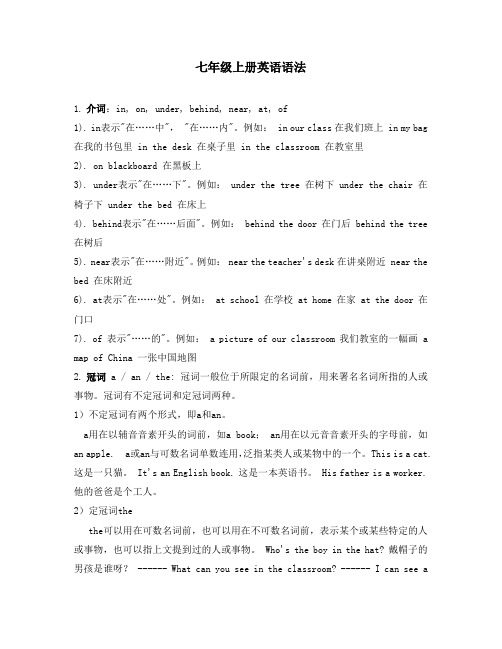
七年级上册英语语法1.介词:in, on, under, behind, near, at, of1). in表示"在……中", "在……内"。
例如: in our class 在我们班上 in my bag 在我的书包里 in the desk 在桌子里 in the classroom 在教室里2). on blackboard 在黑板上3). under表示"在……下"。
例如: under the tree 在树下 under the chair 在椅子下 under the bed 在床上4). behind表示"在……后面"。
例如: behind the door 在门后 behind the tree 在树后5). near表示"在……附近"。
例如: near the teacher's desk 在讲桌附近 near the bed 在床附近6). at表示"在……处"。
例如: at school 在学校 at home 在家 at the door 在门口7). of 表示"……的"。
例如: a picture of our classroom 我们教室的一幅画 a map of China 一张中国地图2.冠词 a / an / the: 冠词一般位于所限定的名词前,用来署名名词所指的人或事物。
冠词有不定冠词和定冠词两种。
1)不定冠词有两个形式,即a和an。
a用在以辅音音素开头的词前,如a book; an用在以元音音素开头的字母前,如an apple. a或an与可数名词单数连用,泛指某类人或某物中的一个。
This is a cat. 这是一只猫。
It's an English book. 这是一本英语书。
His father is a worker. 他的爸爸是个工人。
人教版七年级英语语法归纳
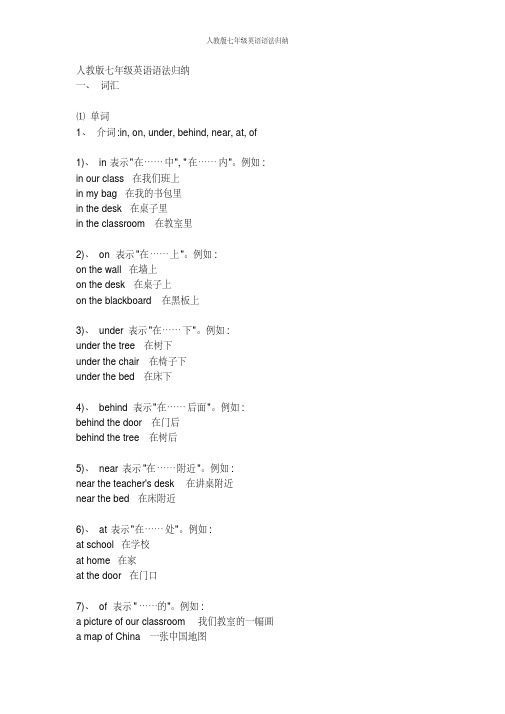
人教版七年级英语语法归纳一、词汇⑴单词1、介词:in, on, under, behind, near, at, of1)、in表示"在……中", "在……内"。
例如: in our class 在我们班上in my bag 在我的书包里in the desk 在桌子里in the classroom 在教室里2)、on 表示"在……上"。
例如:on the wall 在墙上on the desk 在桌子上on the blackboard 在黑板上3)、under表示"在……下"。
例如:under the tree 在树下under the chair 在椅子下under the bed 在床下4)、behind表示"在……后面"。
例如: behind the door 在门后behind the tree 在树后5)、near表示"在……附近"。
例如:near the teacher's desk 在讲桌附近near the bed 在床附近6)、at表示"在……处"。
例如:at school 在学校at home 在家at the door 在门口7)、of 表示"……的"。
例如:a picture of our classroom 我们教室的一幅画a map of China 一张中国地图2、冠词 a / an / the:冠词一般位于所限定的名词前,用来署名名词所指的人或事物。
冠词有不定冠词与定冠词两种。
不定冠词有两个形式,即a与an。
a用在以辅音音素开头的词前,如a book; an用在以元音音素开头的字母前,如an apple、a或an与可数名词单数连用,泛指某类人或某物中的一个。
This is a cat、这就是一只猫。
最全的人教版七年级英语语法总结

7、 有单复数变化的词 ①名词
(1) 名词单数变复数的方法 1)大部分在词尾加 s、如 :dog---dogs 2)以 -s, -x, -ch, -sh 结尾的加 es、 如 :
class---classes bus---buses glass---glasses
box---boxes watch---watches( 手表 )
yuan---yuan( 人民币元 ) 4) mouse— mice ( 老鼠 ) child —children( 儿童 )
5)合成词中一般变后面的词 :apple tree---apple trees(苹果树 ) 但下列需前后都变 :man teacher---men teachers(男教师 )
4、目前学过的后跟动词不定式 (to+动词原形 )的有 : ①would like to+ 动词原形 (想要做某事 ); want to+动词原形 (想要做某事 ); ②forget to+动词原形 (忘记要做某事 ); ③like to +动词原形 (喜欢做某事 ); love to +动词原形 (喜欢做某事 ) ④ask sb、 to +动词原形、 (请 /叫某人做某事 ) tell sb、 to +动词原形、 (告诉 /叫某人做某事 ) would like sb、 to +动词原形、 (想叫某人做某事 ) want sb、 to +动词原形、 (想叫某人做某事 ) ⑤ have to +动词原形 (必须 /不得不做某事 ) ⑥ Nice/Glad/happy to +动词原形 (很高兴做某事 ) 如:Nice to meet you、 I ’ m glad to be he、re 5、目前学过的后跟动词原形的有 : ①情态动词 :can,may,could,would,will 后; ②助动词 do,don ’t,does,doesn后 (’dotes,doesn ’一t出现 ,三单式要滚蛋 );
新人教版七年级英语语法知识点总复习
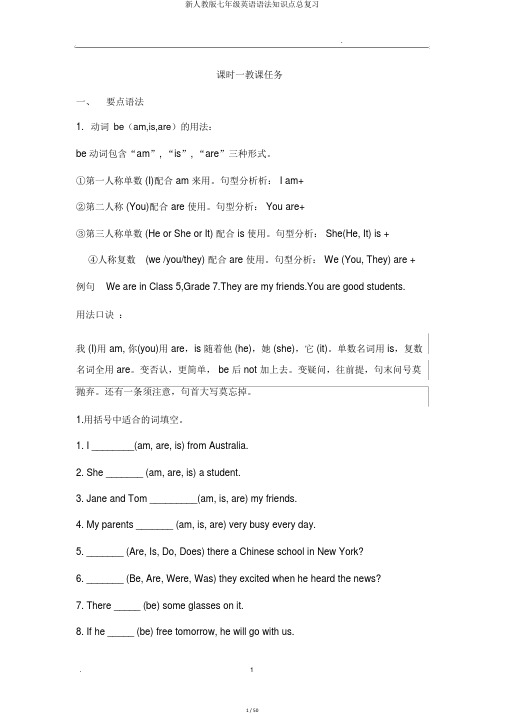
课时一教课任务一、要点语法1.动词be(am,is,are)的用法:be 动词包含“am”, “is”, “are”三种形式。
①第一人称单数 (I)配合 am 来用。
句型分析析: I am+②第二人称 (You)配合 are 使用。
句型分析: You are+③第三人称单数 (He or She or It) 配合 is 使用。
句型分析: She(He, It) is +④人称复数(we /you/they) 配合 are 使用。
句型分析: We (You, They) are + 例句We are in Class 5,Grade 7.They are my friends.You are good students.用法口诀:我 (I)用 am, 你(you)用 are,is 随着他 (he),她 (she),它 (it)。
单数名词用 is,复数名词全用 are。
变否认,更简单, be 后 not 加上去。
变疑问,往前提,句末问号莫抛弃。
还有一条须注意,句首大写莫忘掉。
1.用括号中适合的词填空。
1.I ________(am, are, is) from Australia.2.She _______ (am, are, is) a student.3.Jane and Tom _________(am, is, are) my friends.4.My parents _______ (am, is, are) very busy every day.5._______ (Are, Is, Do, Does) there a Chinese school in New York?6._______ (Be, Are, Were, Was) they excited when he heard the news?7.There _____ (be) some glasses on it.8.If he _____ (be) free tomorrow, he will go with us.2.用 be 动词的适合形式填空1.I ______ a boy. ______ you a boy? No, I _____ not.2.The girl______ Jack's sister.3.The dog _______ tall and fat.4.The man with big eyes _______ a teacher.5.______ your brother in the classroom?6.Where _____ your mother? She ______ at home.7.How _______ your father?8.Mike and Liu Tao ______ at school.9.Whose dress ______ this?10.Whose socks ______ they?11.That ______ my red skirt.12.Who ______ I?13.The jeans ______ on the desk.14.Here ______ a scarf for you.15.Here ______ some sweaters for you.16.The black gloves ______ for Su Yang.17.This pair of gloves ______ for Yang Ling.18.The two cups of milk _____ for me.19.Some tea ______ in the glass.20.Gao shan's shirt _______ over there.第二课时( 1)英语人称代词和物主代词新人教版七年级英语语法知识点总复习.一、人称代词表示“我”、“你”、“他”、“她”、“它”、“我们”、“你们”、“他们”的词,叫做人称代词人称代词有人称、数和格的变化,见下表:单数复数人称主格宾格主格宾格第一人称I me we us第二人称you you you youhe him第三人称she her they themit it人称代词主格:作主语,表示谁怎么样了、干什么了。
人教版七年级英语语法点

人教版七年级英语语法点一、名词。
1. 可数名词与不可数名词。
- 可数名词有单复数形式。
复数形式的构成规则如下:- 一般情况加 -s,如book - books,pen - pens。
- 以s,x,ch,sh结尾的加 -es,如bus - buses,box - boxes,watch - watches,brush - brushes。
- 以辅音字母+y结尾的,变y为i再加 -es,如baby - babies。
- 以o结尾的,有生命的加 -es(如tomato - tomatoes,potato - potatoes),无生命的加 -s(如photo - photos,piano - pianos)。
- 以f或fe结尾的,变f或fe为v再加 -es,如knife - knives,leaf - leaves。
- 不可数名词没有复数形式,如water,milk,bread等。
表示数量时,要用“数词+量词+of+不可数名词”,如a glass of water,two cups of tea。
2. 名词所有格。
- 有生命的名词所有格:- 一般在名词后加's,如Tom's book。
- 以s结尾的复数名词,只加',如the students' classroom。
- 表示两者或多者共有时,只在最后一个名词后加's;表示各自拥有时,每个名词后都要加's。
例如:Tom and Jerry's room(他们共有的房间);Tom's and Jerry's rooms(他们各自的房间)。
- 无生命的名词所有格常用“of+名词”结构,如the window of the room。
二、代词。
1. 人称代词。
- 主格:I,you,he,she,it,we,you,they,在句中作主语。
例如:I am a student. He likes reading.- 宾格:me,you,him,her,it,us,you,them,在句中作宾语。
新人教版七年级上册英语语法、短语和知识点总结
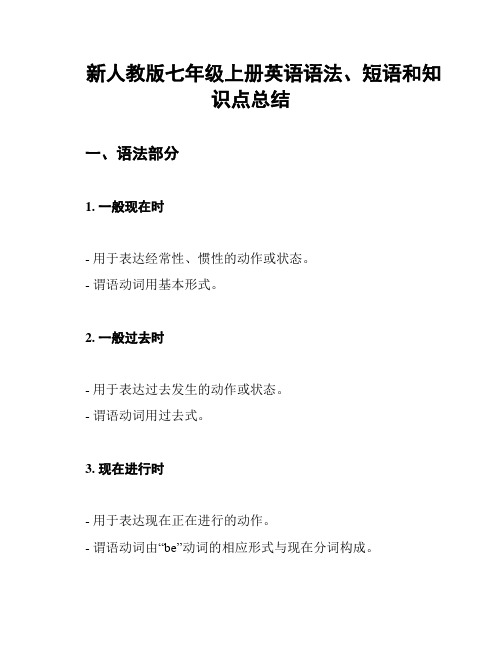
新人教版七年级上册英语语法、短语和知
识点总结
一、语法部分
1. 一般现在时
- 用于表达经常性、惯性的动作或状态。
- 谓语动词用基本形式。
2. 一般过去时
- 用于表达过去发生的动作或状态。
- 谓语动词用过去式。
3. 现在进行时
- 用于表达现在正在进行的动作。
- 谓语动词由“be”动词的相应形式与现在分词构成。
4. 动词不定式
- 作为名词、形容词或副词的补足语。
- 用于表达目的、原因、结果等。
二、短语部分
1. in front of
- 在...前面
2. on the right/left
- 在右边/左边
3. at the back of
- 在...后面
4. go straight
- 直走
三、知识点部分
1. 单复数
- 名词的复数形式变化规则。
2. 冠词
- a/an 用于泛指单数可数名词前。
- the 用于特指名词前。
3. 人称代词
- I, you, he, she, it, we, they。
4. 并列连词
- and, but, or 用于连接并列的词、短语或句子。
四、总结
本文档总结了新人教版七年级上册英语课程中的语法、短语和
知识点。
内容包括一般现在时、一般过去时、现在进行时等语法部分,以及一些常用短语和知识点。
希望对研究者有所帮助。
以上是对新人教版七年级上册英语语法、短语和知识点的总结。
注意:
本文档中的内容仅供参考。
- 1、下载文档前请自行甄别文档内容的完整性,平台不提供额外的编辑、内容补充、找答案等附加服务。
- 2、"仅部分预览"的文档,不可在线预览部分如存在完整性等问题,可反馈申请退款(可完整预览的文档不适用该条件!)。
- 3、如文档侵犯您的权益,请联系客服反馈,我们会尽快为您处理(人工客服工作时间:9:00-18:30)。
人教版七年级英语语法一、be动词(is ,am ,are)的用法二、this,that和it用法三、these和those用法四、不定冠词a和an五、名词+’s所有格六、There be句型七、like一词的用法八、一般现在时九、句子单数变复数,注意以下五要素十、英语日期的表示法十一、名词复数十二、时间的表达法十三、关于时间的问法十四、 want用法一、be动词(is ,am ,are)的用法我(I)用am, 你(you)用are,is跟着他(he),她(she),它(it)。
单数名词用is,复数名词全用are。
变否定,更容易,be后not加上去。
变疑问,往前提,句末问号莫丢弃。
还有一条须注意,句首大写莫忘记。
二.this,that和it用法(1)this和that是指示代词,it是人称代词。
(2)距离说话人近的人或物用this, 距离说话人远的人或物用that。
如: This is a flower. 这是一朵花。
(近处) That is a tree. 那是一棵树。
(远处)(3)放在一起的两样东西,先说this, 后说that。
如:This is a pen. That is a pencil. 这是一支钢笔。
那是一支铅笔。
(4)向别人介绍某人时说This is…, 不说That is…。
如:This is Helen. Helen, this is Tom. 这是海伦,海伦,这是汤姆。
(5)This is 不能缩写, 而That is可以缩写。
如:This is a bike. That’s a car. 这是一辆自行车。
那是一辆轿车。
(6)打电话时,介绍自己用this, 询问对方用that。
如:—Hello! Is that Miss Green? 喂,是格林小姐吗?—Yes, this is. Who’s that? 是的,我是,你是谁?注意:虽然汉语中使用“我”和“你”,但英语中打电话时绝不可以说:I am…, Are you…?/Who are you?(7)在回答this或that作主语的疑问句时, 要用it代替this或that。
如:①—Is this a notebook? 这是笔记本吗?—Yes, it is. 是的,它是。
②—What’s that? 那是什么?—It’s a kite. 是只风筝。
三.these和those用法this, that, these和those是指示代词,these是this的复数形式,指时间,距离较近的或下面要提到的人或事;those是that的复数形式,指时间、距离较远或前面已经提到过的人或事物。
①This is my bed. That is Lily’s bed. 这是我的床。
那是莉莉的床。
②These pictures are good. 那些画很好。
③ Are those apple trees? 那些是苹果树吗?在回答主语是these或those的疑问句时,通常用they代替these或those以避免重复。
如:④Are these/those your apples? 这些(那些)是你的苹果吗? Yes, they are. 是的,他们是。
四、不定冠词a和ana和an都是不定冠词,表示一(个,支,本,块……)的意思,但不强调数量概念,而是强调类别,用来限定名词。
a用在辅音素开头的单数名词前,如:a pencil(一支铅笔),a book(一本书);an用在元音音素开头的名词前,如an eraser(一块橡皮)。
如果名词前有修饰语,用a 还是用an,则以该修饰语的第一音素决定用a还是用an。
如:a clock 一座钟 an old clock 一座旧钟 a book 一本书 an English book 一本英语书 a nice apple 一个可爱的苹果 an apple 一个苹果五.名词+’s所有格名词+’s所有格单数名词后直接加“’s ” Jim’s coat 吉姆的外套 Jeff’s mother杰夫的妈妈以s结尾的复数名词,只加“’”Teachers’ Day教师节 the twins’ books双胞胎的书不以s结尾的不规则的名词复数,加“’s ” Children’s Day 儿童节 men’s shoes男式鞋表示两者共同拥有时,只在最后一个名词后加’s 表示两者各自拥有时,要在每个名词后加’sLucy and Lily’s mother 露茜和莉莉的妈妈(共同的妈妈,一个妈妈) Lucy’s and Kate’s rooms 露茜和凯特的房间(各自的房间,两间房子)六.There be句型(1)There be句型主要用以表达“某处(某时)有某人(某物)。
”其基本结构为“There be+某物(某人)+某地(某时)”其中there是引导词,没有词义;主语是be后面的名词, be 是谓语动词,在一般现在时中be只用is和are两种形式。
下面这首歌诀可帮你巧记there be 句型结构:There be放句首,主语跟在后。
地、时放句末,强调置前头。
如: There is a book on the desk. 有时为了强调地点,也可把介词短语放在句首。
如: On the desk there is a book.(2)There be句型中的be动词如何确定呢?请先看看下面这首歌诀:Be动词,有三个,am,is还有are。
“There be”真特别,不留am只留俩,那就是is还有are。
要用is还是are,须看其后的名词是单数还是复数。
若是单数或不可数名词用is,否则就用are。
如:①There is a tree behind the house.②There is some water(水)in the bottle(瓶子). ③There are some pears in the box.(3)注意:如果“be”后的主语是由and连接的两个或两个以上的名词,那么be的形式要遵循“远亲不如近邻”的原则。
也就是说,“be”的形式是由与它最近的那个名词来确定的。
若那个名词是单数或不可数名词要用is,是复数就用are。
如:There is a book and some pens on the floor. ②There are some pens and a book on the floor. 七.like一词的用法like用作及物动词,译为“喜欢”。
(1)后接名词或代词,表示喜欢某人或某物。
如: I like the baby very much. 我非常喜欢这个小孩。
(2)后接动名词(v. -ing),表示“喜欢做某事”,着重于习惯、爱好。
如: Tom likes playing football. 汤姆喜欢踢足球。
(3)后接动词不定式(to do ),表示“偶尔地喜欢做某事”,着重于某次具体的行为。
如: I like reading, but I like to watch TV this evening. 我喜欢读书,但我今晚想看电视。
八.一般现在时一般现在时表示经常性、习惯性的动作,或表示现在的特征、状态。
当主语是非第三人称单数时,行为动词的一般现在时变化形式(见下表)。
如:句式结构例句肯定句主语+行为动词原形+其他 We speak Chinese.否定句主语+don’t+行为动词原形+其他 We don’t speak Chinese. 一般疑问句 Do+主语+行为动词原形+其他? Do you speak Chinese? 肯定回答否定回答 Yes,主语+do No,主语+don’t Yes, we do. No, we don’t.当主语是第三人称单数时,行为动词一般现在时的句型变化如下: (1)肯定句在行为动词原形后+s/es(其构成方法与名词单数变复数相同)。
(2)否定句用助动词doesn’t+动词原形。
(3)一般疑问句则是把助动词does放在句首,后面动词用原形,回答时,肯定用“Yes,主语+does.”;否定用“No,主语+doesn’t.”。
句式结构例句肯定句主语+行为动词s/es+其他 She speaks Chinese.否定句主语+doesn’t+行为动词原形+其他 She doesn’t speak Chinese. 一般疑问句 Does +主语+行为动词原形+其他? Does she speak Chinese? 肯定回答否定回答 Yes,主语+does No,主语+doesn’t Yes, she does. No, she doesn’t.九.句子单数变复数,注意以下五要素(1)主格人称代词要变成相应的复数主格人称代词,即I→we, you→you,she,he,it→ they。
如: She is a girl. →They are girls. (2)am,is要变为are。
如: I’m a student. →We are students.(3)不定冠词a,an要去掉。
如: He is a boy. →They are boys. (4)普通单数名词要变为复数形式。
如: It is an apple. →They are apples.(5)指示代词this,that要变为these,those。
如: This is a box. →These are boxes.十.英语日期的表示法英语中月份和星期名称都是专有名词,它们的首字母必须大写,并且前面无需用冠词。
用英语表示日期,其顺序为月+日+年,日和年之间需用逗号隔开。
如:August 2nd,2003(20XX 年8月2日)。
也可以用日+月+年来表示。
如:10th May,2003(20XX年5月10日)英语日期前介词的使用:若指在哪一年或哪一月,则用介词in,若具体到某一天,则需用介词on。
①She was born in 1989 ②She was born in August. ③She was born in August 1989. ④She was born on 2nd August, 1989.十一.名词复数:在英语里面,名词分可数名词(countable noun)和不可数名词(uncountable noun),不可数名词没有单复数之分,用时只当单数词用;可数名词有单复数之分,一个的前面要用a 或an,eg: a pencil, a basketball, a dictionary, an egg, an ID card,而复数即两个或两个以上的要作相应的变化,情况如下:(1) 特殊词,特殊变化,需单独记:child→children,man→men,foot→feet,woman→women tooth→teeth,sheep→sheep,deer →deer (2)一般的词在单数词后直接+“s”:book→books,pen→pens,car→cars,map→maps,cartoon→cartoons (3)以s,x,sh,ch 结尾的词+“es” box→boxes,watch→watches(4)以辅音字母+y结尾的名词去掉“y”,改成“i”,再加“es” family→families,comedy→comedies(5)以f或fe结尾的词,先去掉f或fe,改成“v”再加esknife→knives,wife→wives,handkerchief→handkerchieves1.以o结尾的名词顺口溜规律:有生命的以o结尾的名词变复数时,词尾加es,凡无生命的以o结尾的名词变复数时,词尾加s。
